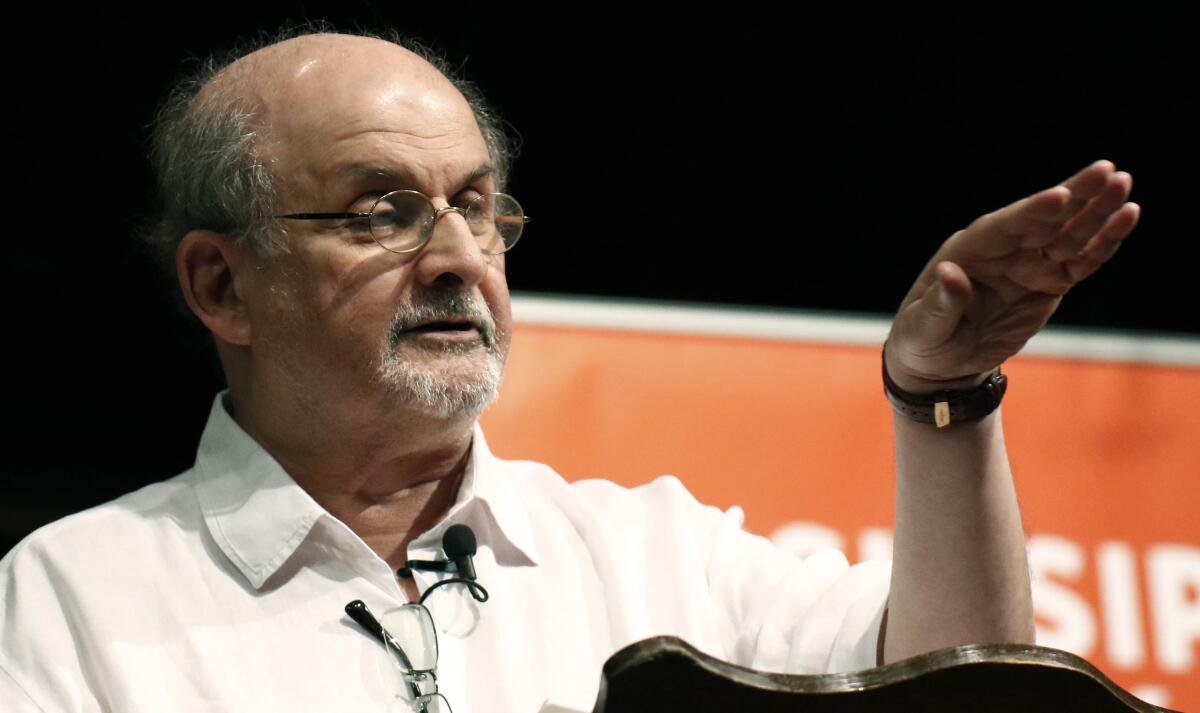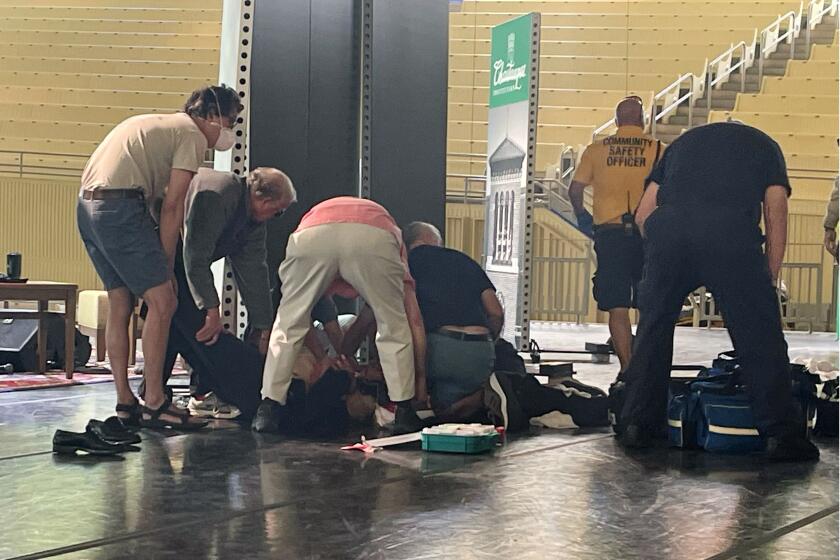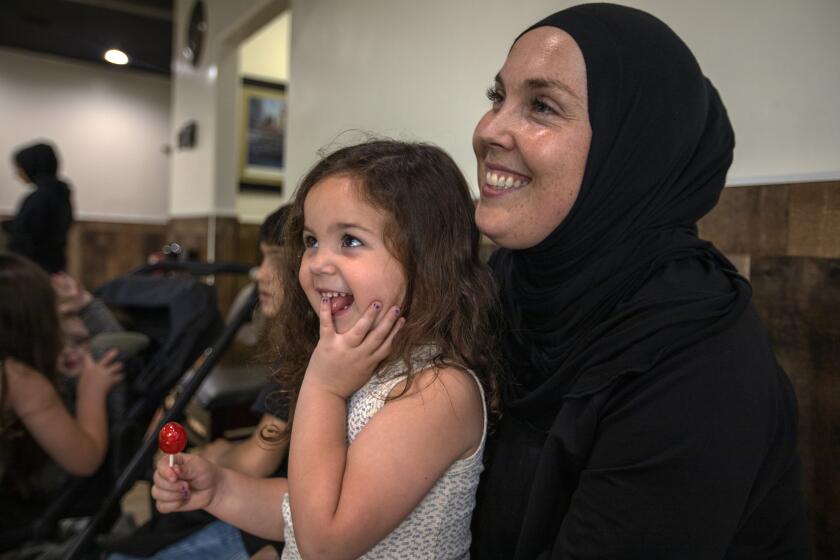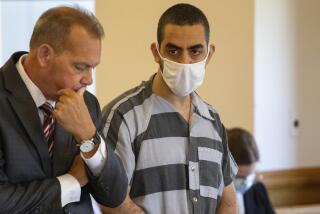What is a fatwa? Salman Rushdie’s backstory moves center stage after attack

- Share via
After Salman Rushdie was attacked as he began a lecture Friday in western New York, it was a potent reminder that an Islamic leader had issued a high-profile edict calling for the writer’s death in reaction to his 1988 novel “The Satanic Verses.”
That death sentence — a fatwa — had immediate effects on Rushdie’s life, spurring him into hiding for the better part of 10 years and dogging him and others around him who were related to the publication of the book.
But what exactly is a fatwa? And how might it be a factor in Friday’s stabbing, which took place in front of a 2,500-person audience?
We’ll need a few basics first.
Who is Salman Rushdie and what is his background?
Rushdie was born in India in June 1947 and grew up in Bombay before relocating to England for public boarding school and then university. He worked as an advertising copywriter for years, then published his first novel, “Grimus,” in 1975. He didn’t gain literary acclaim until his second book, “Midnight’s Children,” won the 1981 Booker Prize, the United Kingdom’s most prestigious literary award.
Rushdie was taken by helicopter to a hospital. “The news is not good,” his agent said, adding that he had nerve and liver damage.
Speaking on PBS in 2006, he characterized himself as “a hard-line atheist.” The writer was knighted in 2007 by Britain’s Queen Elizabeth for services to literature. To date, he has written 14 novels, most recently 2019’s “Quichotte.”
Rushdie has been married four times, most recently to “Top Chef” host Padma Lakshmi from 2004 to 2007. He has two sons — one with his first wife Clarissa Luard and another with his third wife Elizabeth West. His second wife was American author Marianne Wiggins.
What is a fatwa?
In simple terms, a fatwa is a decree from an Islamic religious leader. In Rushdie’s case, Iran’s Ayatollah Ruhollah Khomeini condemned “The Satanic Verses” as blasphemy in February 1989 and called for the writer’s death. Partly because the situation was so high-profile, “fatwa” and “death sentence” became linked in U.S. popular culture.
It has been banned throughout the Muslim world, and at least six people have died in riots against it.
But a fatwa isn’t always about violence. For example, in 2005 a group of U.S. and Canadian Muslim scholars and religious leaders issued the following fatwa: “All acts of terrorism are haram, forbidden by Islam. It is haram, forbidden, to cooperate or associate with ... any act of terrorism or violence.” The edict went on to say all Muslims had a civic and religious duty to cooperate with law enforcement in their effort to protect civilians.
What is ‘The Satanic Verses’ and why was it declared offensive?
“The Satanic Verses” was Rushdie’s fourth novel, published in 1988. The author described the novel, written in English, as primarily a chronicle of the immigrant experience. However, devout Muslims criticized the book’s characterization of Muhammad and other figures of early Islam. Notably, it depicts the prophet as momentarily weak. One Southern California Muslim told The Times at the time, “I think it is an attack on the miracle of the Koran itself.”
Some details about the 1989 Rushdie fatwa
Rushdie immediately went into hiding after Khomeini called for his death that February. Wiggins, his wife at the time, told a U.K. paper that year that they had moved 56 times in five months — every three days — and always had an armed bodyguard in the wake of the announcement on Tehran radio. Khomeini died in June 1989, months after issuing the Rushdie edict, but the fatwa lived on.
In 1993, Ayatollah Ali Khamenei of Iran publicly renewed the death edict against the author. The writer, who was still in hiding, appeared at a Sunday service in Cambridge, England, and told the congregation that he was facing “a straightforward terrorist threat.” He vowed at the time to step up his public appearances.
Patt Morrison talks with Salman Rushdie, the British Indian novelist and essayist.
Has anyone else been caught up in the fallout?
In July 1991, Hitoshi Igarashi, the scholar who translated “The Satanic Verses” into Japanese, was found stabbed to death in the hallway of a building on the Tsukuba University campus, northeast of Tokyo. His body had a deep knife wound in the neck and cuts on the hands and face, police said.
A week earlier, Ettore Capriolo, the man who translated “The Satanic Verses” into Italian, had been attacked at his Milan apartment, suffering knife wounds on his neck, chest and hands. Capriolo survived the attack. The attacker had attempted, unsuccessfully, to get Capriolo to reveal Rushdie’s address.
In October 1993, the novel’s Norwegian publisher, William Nygaard, was shot three times and left for dead outside his home in Oslo. He spent months in a hospital recovering. It wasn’t until 2018 that authorities filed charges and stated that the shooting was linked to “The Satanic Verses.”
We asked readers to share how they were giving back during Ramadan. Here are the stories of Muslims from around California helping seniors, children, the homeless and more.
Has anyone tried to call off the fatwa?
Nope. In 1998, in an attempt to reestablish diplomatic relations with Britain, leader Mohammad Khatami said Iran wouldn’t support or hinder any assassination attempt against Rushdie, but almost a decade later the state news agency said the edict was still in effect.
Over the years, the bounty offered for killing Rushdie has climbed to more than $3 million.
What was Rushdie doing when he was attacked?
Rushdie and lecture moderator Henry Reese were about to discuss “the United States as asylum for writers and other artists in exile and as a home for freedom of creative expression,” according to the website of the Chautauqua Institution, which is known for its summer lecture series.
Others scheduled for upcoming lectures include ballet dancer Misty Copeland, political commentator and L.A. Times contributor Jonah Goldberg and journalist Maria Ressa.
Who is the suspect in Friday’s attack?
A man clad in black and wearing a black mask rushed the stage at the Chautauqua Institution lecture and appeared to punch or stab Rushdie 10 to 15 times before the 75-year-old fell or was pushed to the floor. The man was immediately arrested by a state trooper who was on the scene.
New York authorities identified the suspect Friday afternoon as Hadi Matar, 24, of Fairview, N.J., according to the Daily Beast. Matar has not been charged but stands accused of stabbing Rushdie in the abdomen and neck. A doctor attending the lecture rendered aid immediately before EMTs arrived, law enforcement said, according to ABC News. Rushdie went into surgery, but his condition was not immediately known Friday afternoon.
Also unclear on Friday? Matar’s motive.
Witness Carter Byham told The Times that the suspect “crept up real fast behind him with a short-bladed black knife” and that “the first attack was to his throat on the right side.”
The moderator “tackled the guy,” Byham said.
More to Read
Sign up for our Book Club newsletter
Get the latest news, events and more from the Los Angeles Times Book Club, and help us get L.A. reading and talking.
You may occasionally receive promotional content from the Los Angeles Times.










